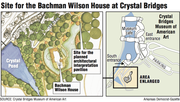Officials at Crystal Bridges Museum of American Art have chosen a spot on the museum’s 120-acre grounds for the Frank Lloyd Wright-designed Bachman Wilson House, which was disassembled at its original site on the Millstone River in New Jersey and is awaiting transport to Bentonville.
The house, one of about 60 Usonian homes that Wright designed between 1936 and the 1950s, will be reconstructed just off the Art Trail near the south entrance to the museum. It should take no more than a couple of minutes to walk there from the south doors, which are near the museum’s Great Hall, said Scott Eccleston, director of facilities and grounds.
The site picked for the house was one of about a half-dozen considered, Eccleston said. The first consideration was for accessibility to all visitors - a challenge with the museum grounds’ hilly terrain.
Then “looking through Frank Lloyd Wright goggles,”a team picked the parcel near the south entrance for its intimacy, connection to the nature around it and view of water, he said. The house will overlook native woodlands, foliage and Crystal Pond beyond that.
“When you enter the sidewalk leading up to this house, it’s almost like you’re going into a different world,” Eccleston added.
At night, the house will be well-lighted - more so than if someone lived there - making it appear as if “it illuminates in the forest,” he said.
The site chosen also allows the building to have the smallest footprint. Preserving the forest around the museum has been a goal since its conception. Crystal Bridges architect Moshe Safdie designed the museum so that the outside walls are within 6 feet of the surrounding trees and brush, leaving as much nature as possible undisturbed.
Crystal Bridges bought the 1954 Bachman Wilson House from the architect-designer team of Lawrence and Sharon Tarantino, who’d owned it since 1988. Waters from the Millstone River some 100 yards away have encroached on the house, and Hurricanes Floyd and Irene did considerable damage, the couple told New Yorker magazine in an article published last month.
The Tarantinos started shopping for a buyer for the house in 2012, hoping to find someone who would move it to another natural habitat.It was announced in January that Crystal Bridges had bought the house and would relocate it as an exhibit at the museum.
Eccleston said the Bachman Wilson House will be rebuilt as it is today, with all of its age wrinkles. Settling and other structural changes that have occurred over the past 60 years have been documented in a booklet put together by the Tarantinos so those structural changes can be retained.
The house, with each piece individually wrapped and packed, is being brought to Arkansas free of charge by Lowell-based J.B. Hunt Transport Services Inc.
Faculty members and students at the University of Arkansas Fay Jones School of Architecture are working in a studio class this spring to design an architectural interpretation pavilion to be built near the Bachman Wilson site. It will be close enough for students to monitor reconstruction but far enough away not to distract from the house.
The late architect Fay Jones was an apprentice of Wright’s, and their architectural styles reflect that. The pavilion will be constructed during the summer.
“It will be used by students during the fall semester while they analyze and document the reconstruction of the house for inclusion in the Historic American Buildings Survey,” said Diane Carroll, director of communications for the museum. The survey, begun in 1933, documents America’s architectural heritage.
Once the house is reconstructed next spring, the museum plans to use the pavilion as a place where visitors can learn more about the house.
Preparing the site for the Bachman Wilson House should begin within a couple of weeks, Eccleston said. A contractor has been hired to rebuild the house, but the name of the company has not been made public.
Getting construction equipment to the site will be challenging.
“Ultimately, we’ve found that the things that are the most difficult turn out to be the most beautiful,” he said.
Arkansas, Pages 13 on 04/06/2014

